Efficient project management is a must-have when delivering projects on time, within budget, and satisfying all stakeholders.
But what does best-practice project management look like, what are the best frameworks to use, and what features make or break the software you choose?
Our definitive project management guide answers all these questions and more. You’ll learn about project management processes, the best frameworks, and how to manage a project effectively.
What is project management?
Project management is the application of processes, methods, skills, knowledge, and experience to deliver the project goals within scope, time, and budget constraints.
Project management (PM) is the practice of planning and managing projects, from start to finish. It involves coordinating all the necessary activities and resources to meet deadlines and achieve your desired project outcome. For example, your goal might be to launch a new product, develop software, or plan a networking event. To achieve your end goal, project management includes:
- Setting goals
- Scheduling tasks
- Managing teams
- Monitoring progress
- Collaborating with stakeholders
Numerous structured frameworks, such as Agile, Kanban, or Scrum, can help you achieve your project objectives. Although these frameworks take different approaches, each focuses on taking the necessary steps to complete your project on time and within budget.
Why is project management important?
Project management is critical because it provides the leadership, motivation, and problem-solving that enable teams to introduce new products or services, grow revenue, and meet company goals. If you prioritize effective project management styles, you can proactively and continuously improve workflows to avoid any mistakes, overspending, or other project challenges.
The most successful companies know how to manage a project to remain efficient and productive.
Who uses project management?
All types of organizations use project management, from small and medium-sized businesses to large multinationals. Whether you are leading a team in the office or remotely managing teams around the world, effective project management ensures your organization reaches its goals.
Project management encompasses any type of project, including (but not limited to):
- Product and service development
- Software engineering
- Event planning
- Construction projects
- Marketing campaigns
- IT system implementations
Traditionally, a project manager heads up the project team and is responsible for the project’s overall success. The manager assigns tasks to team members, tracks progress, and ensures that deadlines and budgets are met. However, in smaller teams without a dedicated project manager, several team members can share the responsibility for project management.
A brief history of project management
The history of project management spans thousands of years, with early examples, such as the construction of the Great Pyramid of Giza around 2570 BC and the Great Wall of China in 208 BC, demonstrating the basic principles of organization, planning, and resource management.
The foundations of contemporary project management were laid during the Industrial Revolution of the 19th century, with pioneers like Frederick Taylor and Henry Gantt developing methods to optimize workflows and visualize project schedules.
It continued to evolve throughout the 20th century when professional organizations like the International Project Management Association (IPMA) and the Project Management Institute (PMI) were established to promote and standardize project management practices. Since then, computer technology, project management software, and agile methodologies have made project management more flexible.
Project management approaches
It’s important to remember that there’s no one-size-fits-all approach to project management. The best methodology often depends on the specific needs and constraints of the project and organization, such as:
- Project complexity and scope
- Flexibility of the work environment
- Alignment with organizational goals and team values
- Industry requirements and regulations
Many successful project managers adapt and combine different approaches to create a tailored methodology that works best for their particular situation. Here are four of the most common project management approaches:
Predictive project management
The predictive project management/ traditional project management — also known as the Waterfall methodology — is a linear, sequential process in which each phase must be completed before proceeding to the next. It’s best suited to projects with clearly defined goals and requirements that are unlikely to change. Examples of predictive project management include the Critical Path Method (CPM) and PRINCE2.
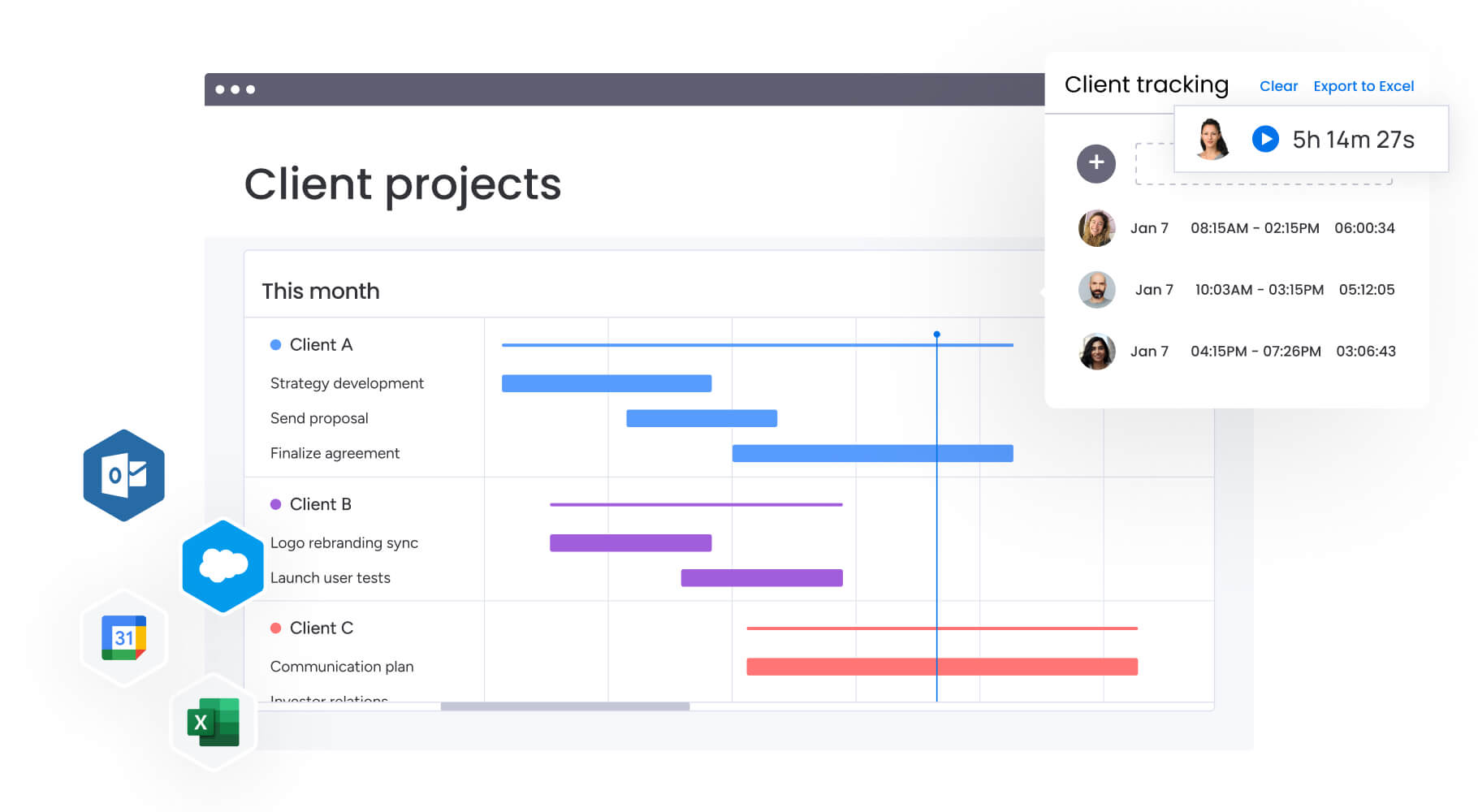
Adaptive project management
The adaptive (agile) approach is a flexible, iterative process that breaks projects into short “sprints,” incorporates frequent feedback, and allows for changes throughout the project. It’s well-suited for projects that may evolve or require adaptability, like product development. Examples of adaptive project management include Scrum, Kanban, and Extreme Programming (XP).
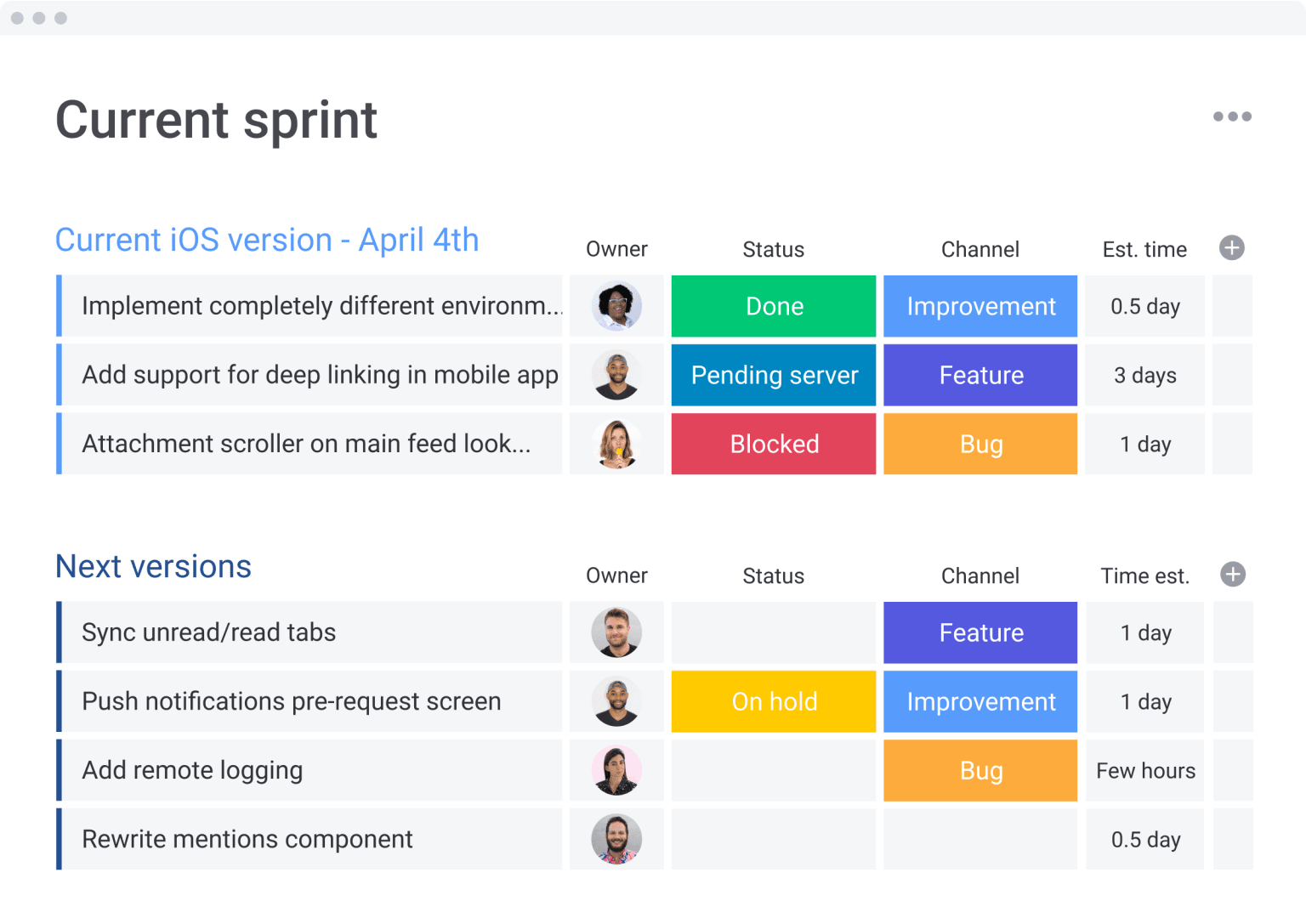
Hybrid project management
The hybrid approach combines elements of both predictive and adaptive methodologies. It allows teams to use the best aspects of each approach depending on project needs and can be customized to fit specific organizational requirements. The best example of hybrid project management is Scrumban, which combines elements of Scrum and Kanban.
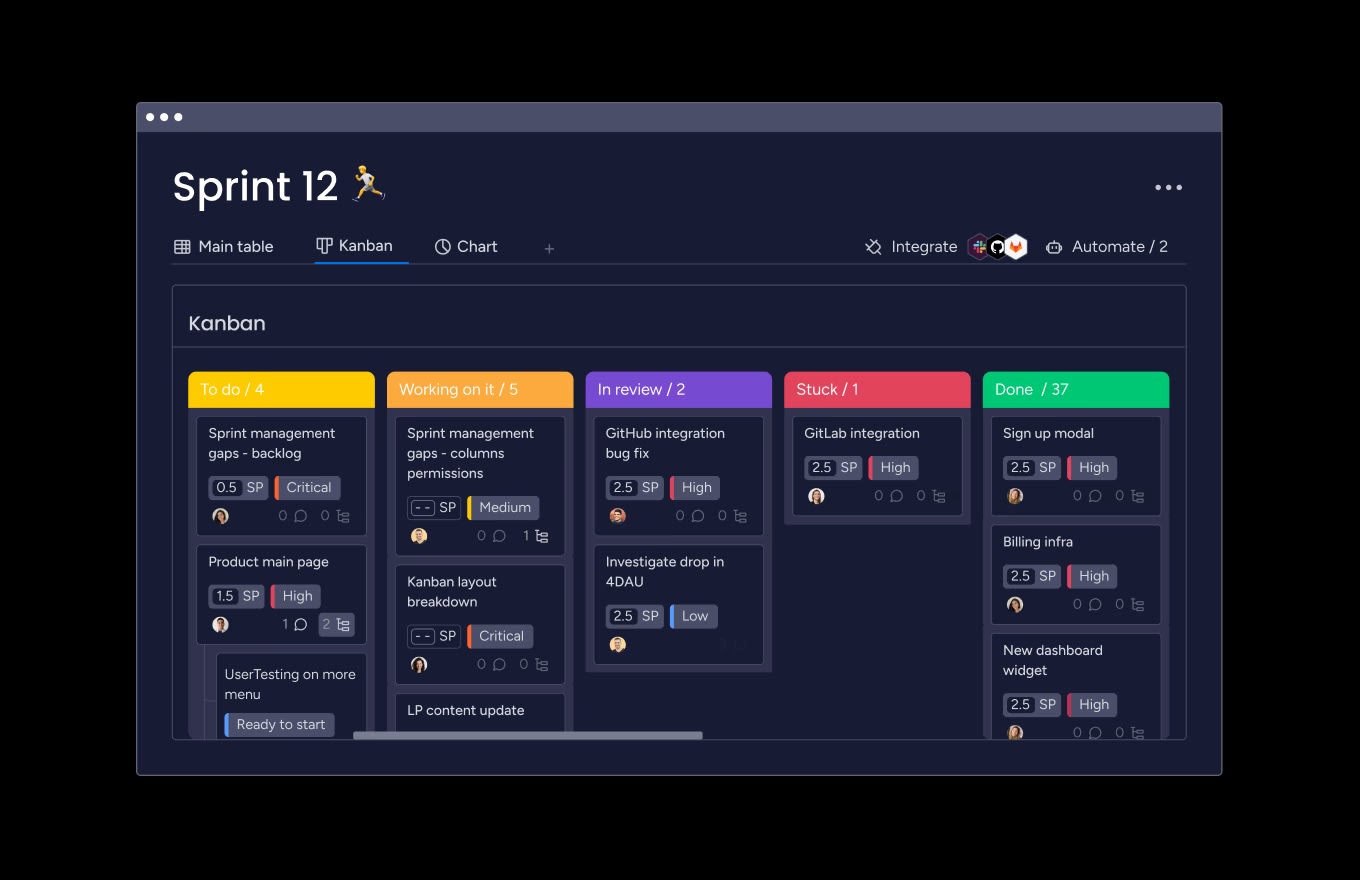
Six Sigma project management
The Six Sigma approach focuses on improving quality by reducing errors and defects, and uses statistical tools to identify and eliminate causes of variation. It’s often used in large organizations to improve processes and eliminate waste, and includes methodologies like DMAIC (Define, Measure, Analyze, Improve, Control).
Project portfolio management (PPM)
When you manage multiple complex projects then it’s called a portfolio. Portfolio management is a method used by organizations to manage multiple project and programs in a single portfolio, aligning them with strategic goals and maximizing value to the business.
Strategic portfolio management deals with selecting, prioritizing, and managing projects and connecting them to the overall strategy of the business (making sure that resources, investments, and efforts are all aligned).
What are the areas of project management?
The Project Management Body of Knowledge (PMBOK® Guide) defines ten key project management knowledge areas. These areas cover the core aspects of managing a project successfully and provide frameworks for planning, executing, monitoring, and controlling projects across different industries.
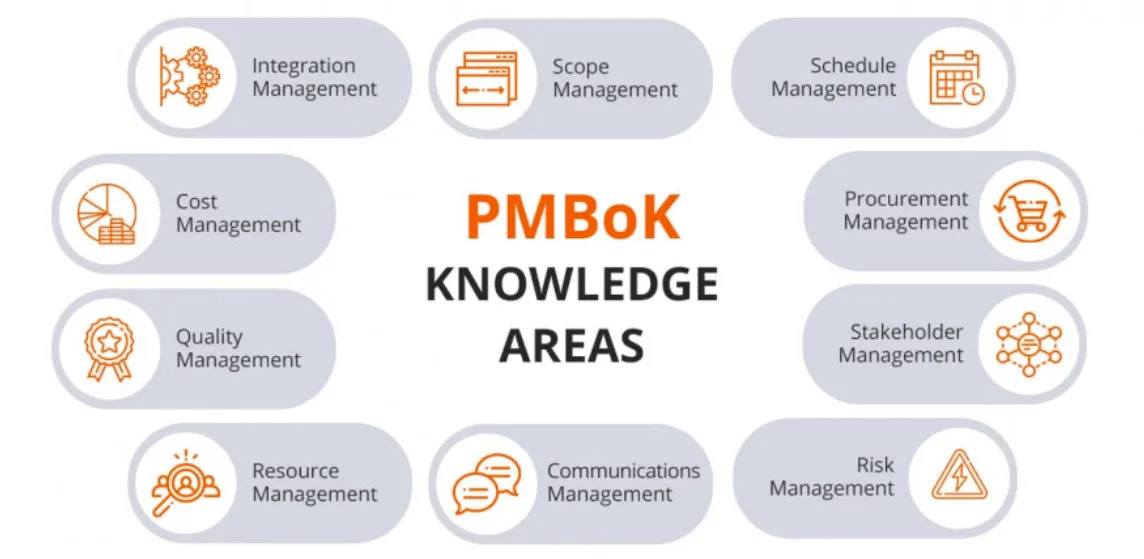
- Integration management: Coordinating all aspects of the project to ensure they work together cohesively.
- Scope management: Defining and controlling what is and isn’t included in the project.
- Schedule management: Planning and controlling the project timeline and schedule.
- Cost management: Estimating, budgeting, and controlling project costs.
- Quality management: Ensuring the project meets quality requirements.
- Resource management: Organizing and managing project team members and physical resources.
- Communications management: Planning and executing effective project communications.
- Risk management: Identifying and managing project risks and uncertainties.
- Procurement management: Acquiring goods and services needed for the project from external sources.
- Stakeholder management: Identifying and engaging with project stakeholders.
What tools are used in project management?
The specific tools used in project management can vary based on the methodology — e.g. Agile, Waterfall — and the organization’s needs. Many modern project management software platforms combine multiple tools into comprehensive solutions. Some of the key project management tools include:
- Gantt charts for scheduling and tracking project tasks and milestones in visual timelines.
- Work breakdown structure (WBS) to divide the project into smaller, manageable components.
- Project baseline for measuring project performance against the original plan.
- Dashboards to provide at-a-glance views of project status, metrics, and KPIs.
- Task management tools such as task lists, Kanban boards, and project calendars for organizing and tracking work.
- Resource management tools for allocating resources and managing team workloads.
- Time tracking and timesheets to log hours worked and track time spent on tasks.
- Budgeting and cost management tools for tracking expenses and managing the project budget.
- Risk management tools to identify, assess, and mitigate project risks.
- Collaboration tools like chat, file sharing, and virtual meeting software to facilitate team communication.
- Reporting tools for generating status reports and other project documentation.
- Portfolio management tools to manage and align multiple projects.
- Workflow automation for streamlining repetitive processes.
- Mobile apps to access project information on-the-go.
- Integrations with other business software like email, calendars, and file storage.
Project management templates
Project management templates save project managers countless hours when starting a new project. Instead of starting each project with a blank sheet, you can use templates to fill in the placeholders, replicate and reuse the structure of previous projects, and standardize your processes.
Here’s a selection of monday.com project management templates you can use to get your projects up and running in next-to-no time:
- Single project template
- Project portfolio management template
- Agile project management template
- Project workflow template
- Risk register template
Learn more in our guide to project management templates.
- Resource management template
- Project cost management template
- Project timeline template
- Program risk register template
Learn more in our guide to writing a project plan.
Learn more in our guide to project charter templates.
Key project management roles
Project management roles may vary depending on the organization and project size, but these represent the core functions typically involved in project management.
1. Project sponsor
- Provides financial and organizational support for the project
- Makes critical decisions on resources and budget
- Communicates project progress to stakeholders
2. Project manager
- Oversees the entire project from start to finish
- Defines project goals and creates plans
- Allocates resources and ensures the team stays on track
- Manages budget, risks, and timelines
3. Team members
- Carry out day-to-day tasks to complete the project
- Collaborate and report progress
- Contribute expertise to ensure project success
4. Project stakeholders
- Have a vested interest in the project’s outcome
- May include customers, suppliers, regulatory bodies, etc.
5. Project customer
- Defines project objectives and requirements
- Approves the final product or service
6. Project Management Office (PMO)
- Develops standards and policies for project management
- Supports project managers and archives project data
7. Steering committee
- Provides governance and oversight
- Ensures projects align with organizational goals
What are the 5 phases of project management?
Successful project management begins with designing and following a simple roadmap to set expectations. As Matt Burns, a project manager at monday.com, says:
The number one thing to do before initiating any project is to outline the project roadmap at the beginning. Because if you want to go somewhere and you don’t have this map, you’re probably going to get lost.
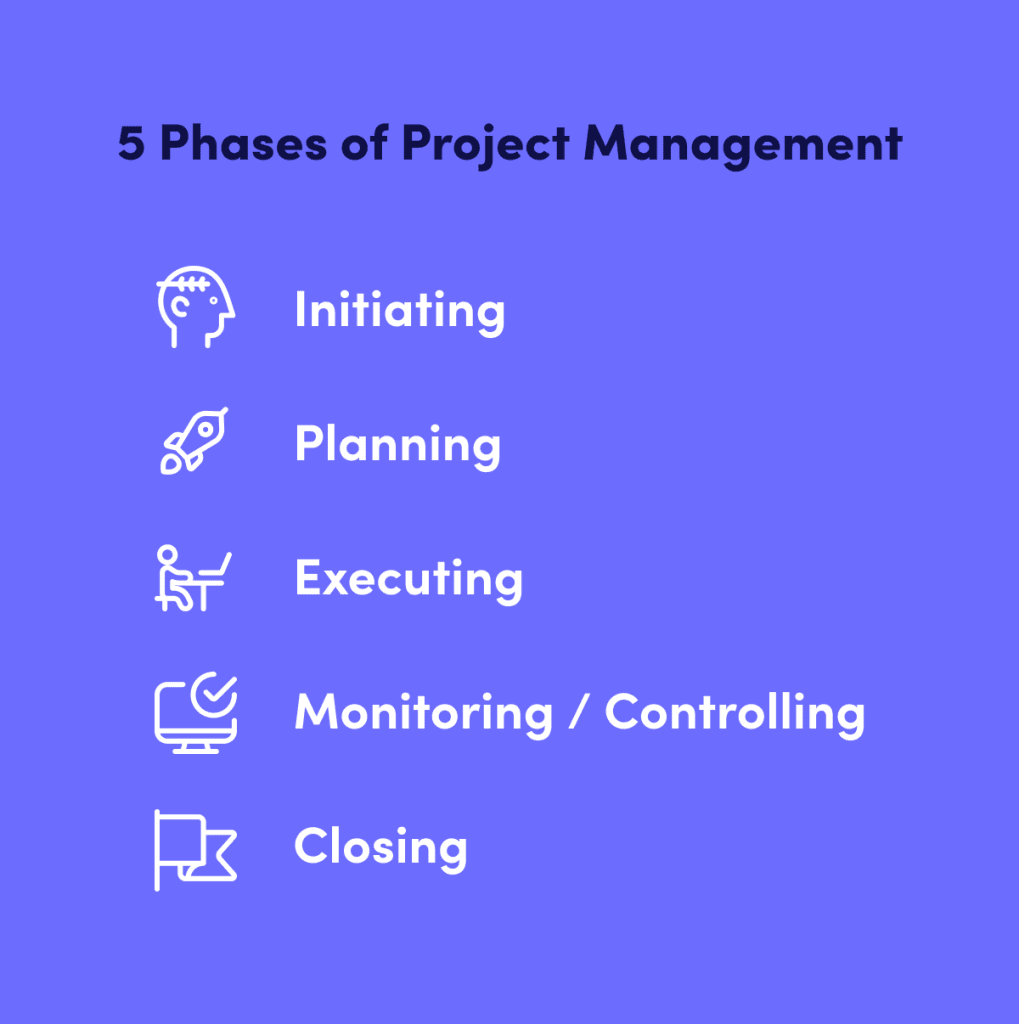
To help you develop your roadmap, let’s dive into five essential phases in the project management lifecycle. Here’s the high-level information you need to know about each.
1. Initiating
As with any good project, preparation is vital to complete the work on time and within budget. During the project initiation phase, determine the following to create the project foundation:
- Project scope: This covers the specific limits and boundaries for the project, including what you’ll accomplish and what you will not (i.e., the project objectives). Establishing these boundaries prevents something called “scope creep,” where the deliverables change and your project deadlines may get pushed back.
- High-level project overview: This outlines the resources, time, and goals required to complete a project and a strategy to monitor these requirements over time.
- Budgets: You’ll liaise with stakeholders to determine the amount of money available for your project and the cost required to achieve a successful project.
For larger projects, you might establish a project charter or “Project Initiation Documentation” (PID), which goes into these areas in more depth.
2. Planning
Drawing up a clear and intentional project plan ensures all team members move toward the same goal. During the project planning phase, you’ll:
- Select your project team members
- Outline your deliverables
- Estimate your required project resources
- Determine any associated activities
- Set key milestones and dates, including the final project completion date
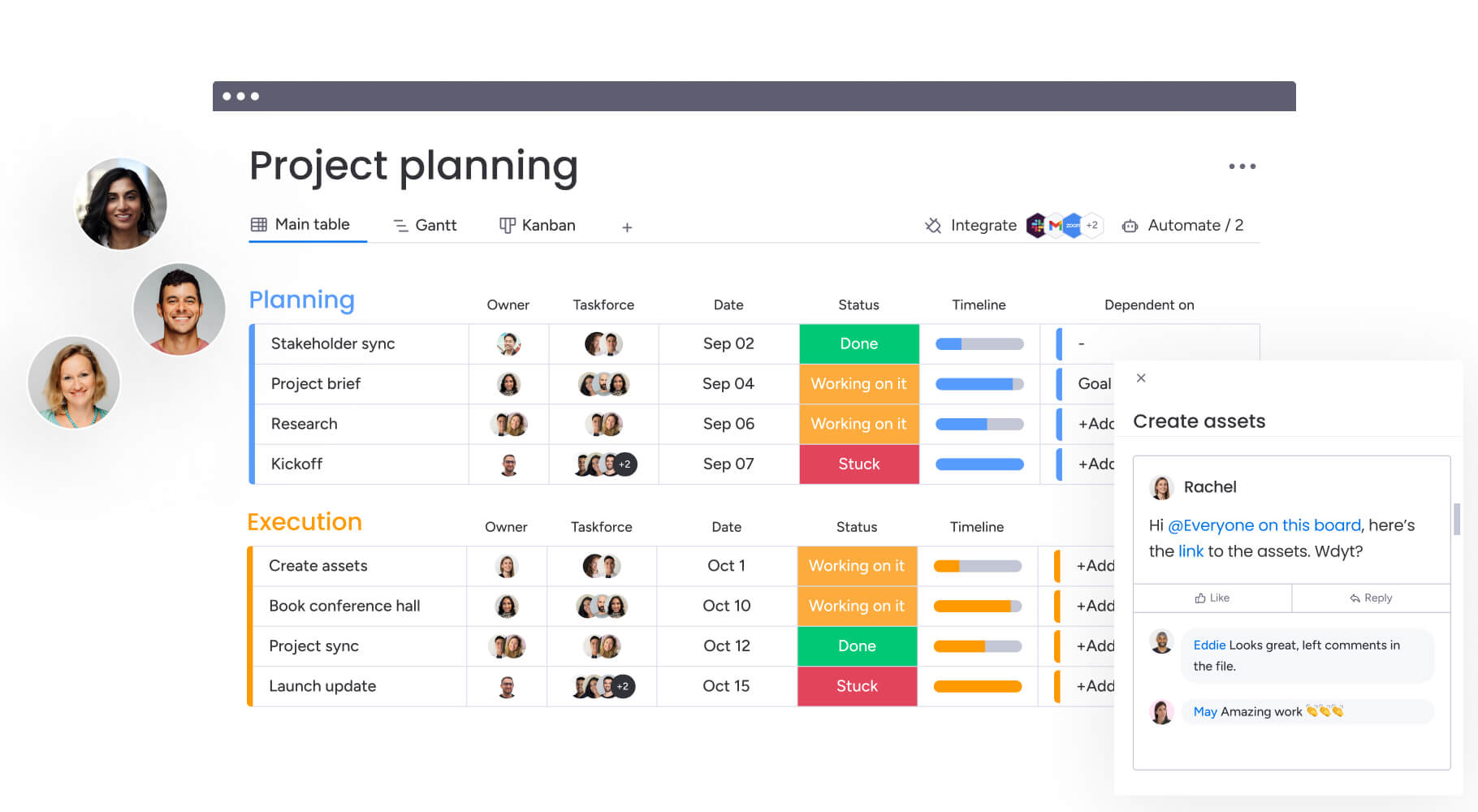
During this process, you can also outline the team’s project management methodology. There are many to choose from, including the popular options below. We’ll get into more specifics about some of these later in this project management guide.
- Agile
- Waterfall
- PRINCE2
- Scrum
- Lean
- Kanban
3. Executing
During the project execution phase, you will carry out the details of your project plan (or project deliverables) to deliver your products to your specific stakeholders. This stage occurs simultaneously with the monitoring and controlling phase (below) and might involve:
- Managing workflows
- Recommending changes
- Suggesting corrective actions
Ultimately, it’s about staying in control, collaborating with the entire team, and staying on track.
4. Monitoring/Controlling
Constant monitoring is essential in any project life cycle as it helps project managers answer the question: “Where are we vs. where should we be according to the project plan?” Effective monitoring requires:
- Regular, consistent project “check-ins.”
- Using proper project documentation and tracking tools to visualize project progress, such as Kanban Boards, Gantt Charts, and Workload Views — just some of the 15+ dynamic board views available in monday work management.
The more visual and real-time this is, the better.
5. Closing
This final step, sometimes known as “project delivery” or the project closeout phase, is when you wrap up all activities and deliver the final product. This handover might be to the client, an internal team, or an external stakeholder. Some additional components could be:
- Concluding any formal contracts or agreements.
- A full review or audit of what went well, what didn’t go as planned, and how future teams could learn from this project.
What are the four types of project management?
You can use several project management types and frameworks to manage projects successfully. Choosing the right one is crucial because it dictates how you structure your team and how you plan and monitor your projects.
As promised, here are high-level descriptions of the leading project management frameworks (with links to even more comprehensive deep dives). We also have a great blog on top project management methodologies to further help you understand your options.
1. Waterfall project management
Waterfall or traditional project management focuses on “perfect planning” by breaking down and scheduling the entire project from start to finish. It’s sequential with little room for iteration, meaning that your project will progress through defined stages, with one stage beginning only after you’ve completed the previous stage. See here for a full review of agile vs waterfall methodologies.
Best for: Teams who can accurately define all project requirements and details upfront, and are comfortable with set-in-stone deadlines.
Check out our complete guide to Waterfall project management here.
2. Agile project management
Agile is an iterative approach to project management that enables teams to react quickly to project feedback. It’s a popular framework for tech projects such as software development, as it prioritizes adaptability, collaboration, and incremental delivery, which are all essential when testing and adjusting new digital products. Agile project managers break their projects down into small, manageable iterations called sprints, and rely on constant feedback from stakeholders to make quick changes and ensure the final product meets the project goals.

For many teams, having the flexibility to amend project details is integral to a successful project completion. However, the challenge with using an Agile approach is that it can be hard to scale this framework beyond a smaller team level as it relies on smaller increments and details. Check out our walkthrough to learn more about running your next project using an Agile framework.
Best for: Software development teams working on complex projects with evolving requirements.
3. Kanban project management
Kanban project management focuses on continuous improvement by visualizing and managing the flow of work. A Kanban project management board is divided into columns representing different stages of work and tasks move across the board as the project progresses.
Unlike the sequential Waterfall approach, Kanban enables continuous adaptation as teams track tasks, respond to changes quickly, and identify and resolve bottlenecks. It’s an ideal fit for teams with many incoming requests, such as IT teams. To learn more about Kanban project management, check out our guide.
Best for: Projects requiring continuous flow and focus on optimizing work processes, particularly when dealing with maintenance tasks, support requests, or projects with unpredictable workloads.
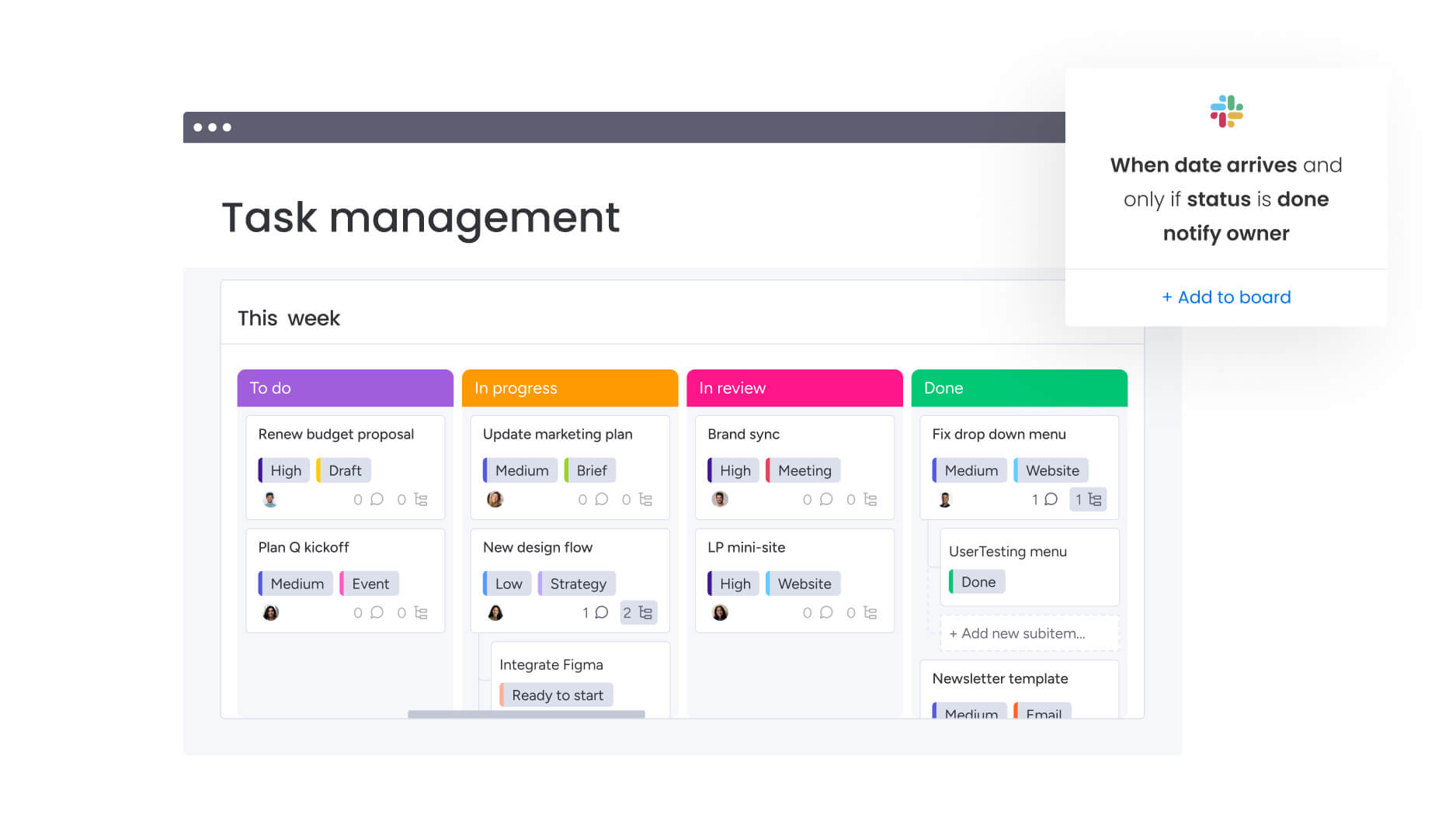
4. Scrum project management
The Scrum framework is another popular way to implement Agile project management. It divides larger projects into shorter, 1–4 week sprints that adapt to demands as the project evolves. It also lays out rules for team size, team roles, planning, meetings, deliverables, and more.
Best for: Teams that seek to deliver functioning increments of their work during a project, such as marketing campaigns, product design, or other creative projects.
Read our guide on the Scrum methodology to learn more.
8 tips for successful project management
With solid project management, companies can develop new products or services, optimize internal business operations, and provide customers with value — all with less friction and more efficiency. These building blocks create innovation and control essential resources like time and money. To help you succeed with project management, we’ve put together eight tips to propel your organization instead of holding it back:
1. Invest in the initiation and planning stages
When it comes to answering, “Why do projects fail?” many of the reasons can be traced back to poor planning and research—crucial parts of the initiating and planning stages of the project life cycle.
By establishing, syncing, and agreeing on key aspects such as organizational priorities, objectives, and requirements early on, you’ll reduce the odds of confusion later.
2. Pick the right framework or methodology for your project
The second step toward successful project management is finding the right framework or methodology. Whether you use a critical path methodology to determine project duration or a Waterfall methodology to provide clear project stages, your choice of framework will determine how you visualize, prioritize, and complete each project stage.
3. Promote a culture of transparency and ownership
Transparency makes all the difference when managing a project as complexities and sensitivities arise. With a strong culture of transparency, team members and leaders rely on each other to raise flags or take ownership of their work, regardless of how granular or stressful plans get.
This starts with clear communication, so each project contributor can understand your long-term goals, KPIs (key performance indicators), plans, and where they fit into the puzzle. One way to achieve this is to involve every employee at some level in the planning process, and give them ownership over tasks and deliverables. To do this, a platform like monday work management enables you to create a versatile project management workflow that you can customize to your unique requirements.
4. Decide on a realistic scope
Scope creep is a key challenge project managers face when unexpected work or project changes crop up. While this could be related to uncontrollable factors throughout a project, having the right people at the planning table can help you more accurately define the project scope and prevent things from going off track. One way to set realistic scope is to refer back to old project data to make projections.
5. Prioritize efficient scheduling
If you want your team to stay productive, you need to create work schedules that are realistic to your team’s workloads and the intended delivery date. Balancing these two factors is a worthwhile investment of your time.
Clearly communicated schedules mitigate delays and costly setbacks. The type of project management methodology you use shapes communication and can affect how your team uses its time to reach a goal. If you use an Agile framework like Scrum, you will focus on the short-term and smaller deliverable increments. It’s also important to schedule time for things you don’t plan for.
With a Work OS like monday.com, you can see individual or team workloads with Workload View in the same workspace where you manage calendars, timelines, and resources.
Get started6. Practice effective resource management
Resource management is an important tenet of project management and describes the process of pre-planning, scheduling, and allocating your resources to maximize efficiency. These resources might include people, capital, and other material goods.
An example of physical resource management could be a contractor managing construction projects — they could decide to book a concrete pourer for two sites instead of having to pay the cost for two simultaneously.
For digital projects, resources often refer to specific employees or teams. A graphic designer may have several concurrent projects, so you’ll need to plan according to their schedule to complete the job.
7. Engage your stakeholders
A stakeholder is someone directly invested in the project’s success. They could be a key client, internal product user, executive, or product manager.
A successful project relies on strong communication and input between all parties before, during, and after a project. Each stakeholder offers unique insights and perspectives relative to the organization’s goals and the team’s capabilities. monday work management offers collaborative dashboards with 30+ drag-and-drop widgets you can use to display high-level project data, enabling all stakeholders to make fast, sharp decisions.
8. Choose next-level project management tools and software
To succeed in remote work, you need a modern Work OS platform that enables inter-departmental collaboration, cloud file sharing, and many other use cases unique to your company. Our project management platform — built on the versatile and intuitive monday.com Work OS — provides the complete toolkit for every project.
With monday work management, you can shape workflows and boost your team’s efficiency and productivity by customizing any workflow to fit your needs. This allows you to work in whatever project management framework you prefer. With views ranging from our Kanban Board, Gantt Chart, Timeline, and Calendar Views, you can customize the experience to your workflow and use color-coding to quickly understand project statuses. You can also seamlessly integrate monday.com with other tools in your tech stack, sharing boards, project status dashboards, and project updates with your entire team in real time.

You can get started with monday work management now, or keep reading to learn more about how to get the most out of project management software.
Get started6 steps to get the most out of project management software
While spreadsheets, email, and whiteboards may suffice for simple and small-scale projects, large and complex projects require a robust project management platform.
From platform-specific templates, boards, and workflow automations to collaboration tools and integrations, monday work management gives you all the functionality you need.
You can set up a digital workspace like monday PMO work management to empower your project teams.
1. Use project documentation to speed up framework adoption
Create clear project documentation by recording key project details that guide your teams in planning and executing successful projects. Documentation is even more critical when coaching multiple teams on how to use a specific project management methodology.
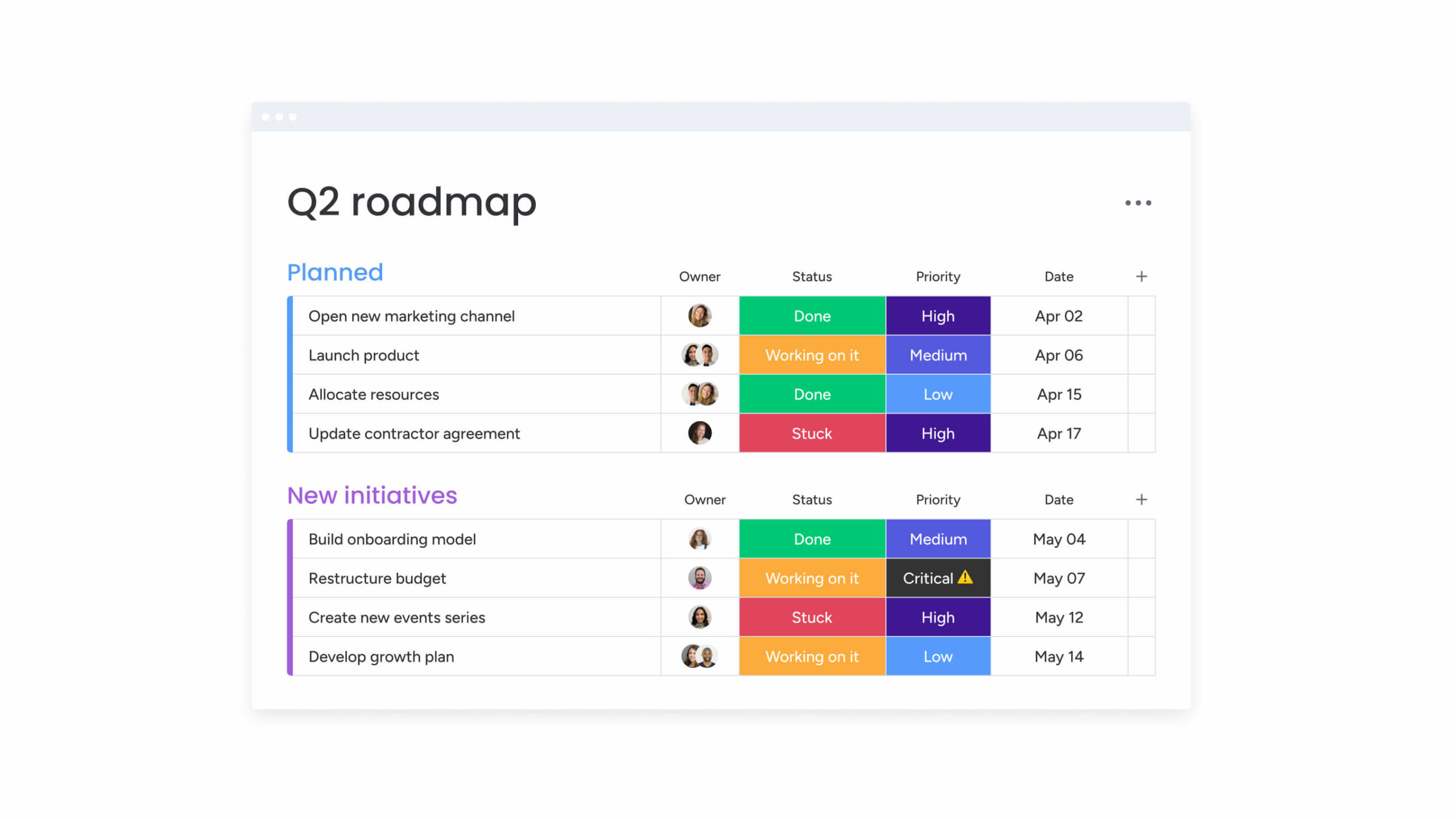
With a Work OS, you can create, share, and collaborate on documents from within your workflow—or larger workspace. For example, with monday workdocs, team members can explore and understand in real-time the flow of a project and their part.
2. Create your roadmap and high-level project plan
A project roadmap is a visual, high-level overview of a project’s goals and deliverables organized on a timeline. This is useful for managing stakeholder expectations, communicating plans, and coordinating resources with other teams.
Project management software allows you to create a living and dynamic document that everyone can easily access. Better yet, project roadmap templates like this one from monday.com can help you get started even faster.
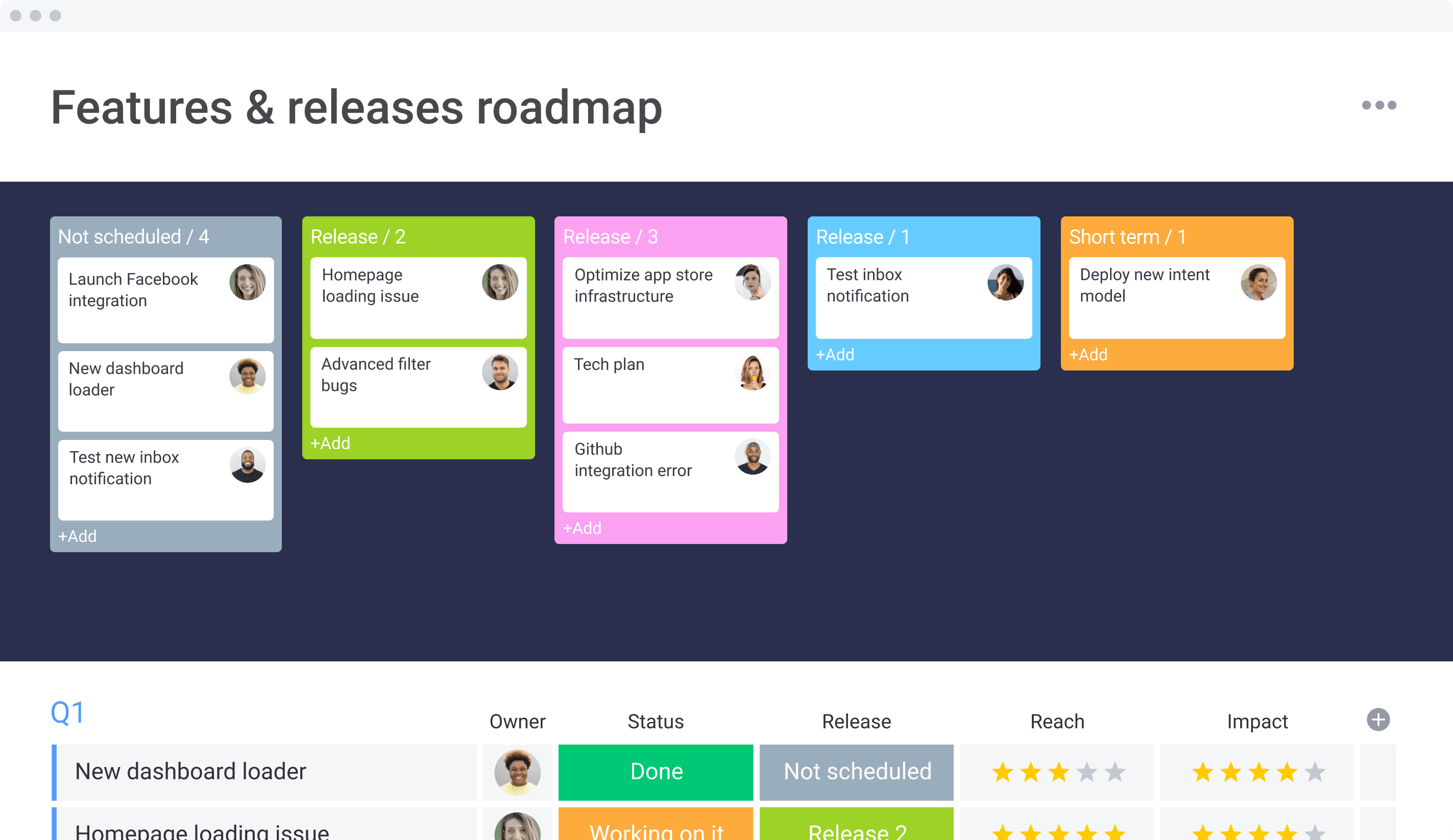
3. Build a customized workflow
Once you have a roadmap or some other high-level project plan, it’s time to get more granular with your workflows. This crucial step makes it easy and intuitive for your team members to execute their work and for project managers to monitor and control project progress.
Use customizable templates in your Work OS to accommodate different project methodologies, add different views, automations, and more.
With monday work management, you can build any workflow, from work breakdown structures (WBS) to risk registers, project proposals, and resource management.

4. Encourage ownership
PMO resource management in monday work management enables project managers to understand individual team member capacities, and plan accordingly. This feature allows easy assignment of tasks and subtasks to individual employees and teams, empowering everyone to remain accountable for their work. You can even implement automations that send notifications to task owners when a project phase is complete.
In addition to assigning task owners, it’s also a good idea to give each team member simple responsibilities like reporting on progress during status meetings and identifying their roadblocks. This helps maintain a culture of transparency and builds momentum.

5. Display key data for faster decision-making
Take your projects to the next level with actionable insights, all displayed on dynamic dashboards in monday work management. Here’s some data you might like to track:
- Time Tracking Column: This allows teams to see how long tasks take.
- Customizable Status Column: Any stakeholder can see the current status of your projects, and common bottlenecks.
- Deadline Column: This date field holds every team member accountable for the project’s success.
Once you’ve created different workflows, use them as a resource and easily create reports and dashboards. Assess project success against KPIs, then use this data to guide decisions or new projects.
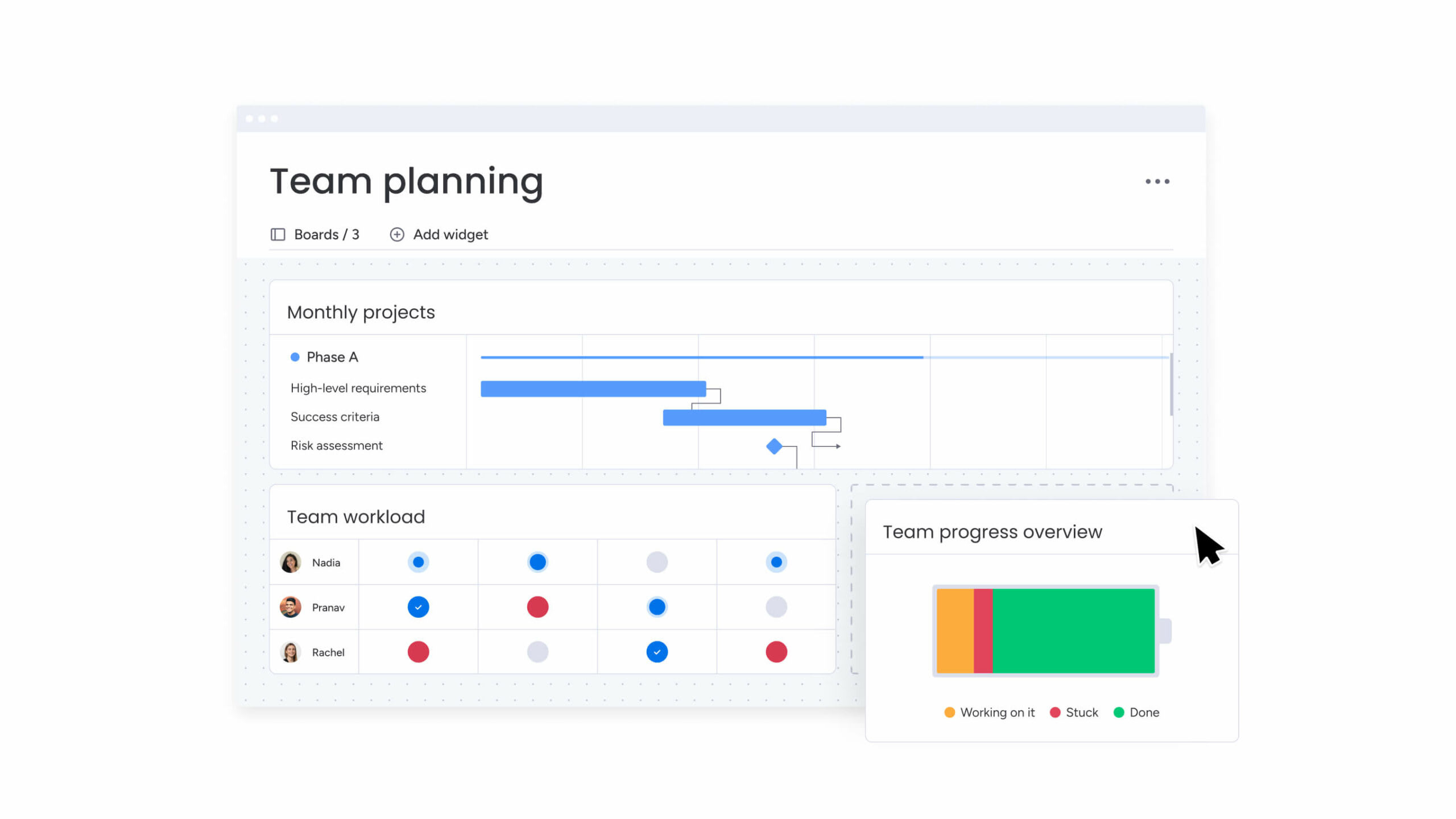
6. Automate repetitive tasks to speed up project management
Automations can speed up your workflow for more efficient project management. For example, you can notify managers automatically when due dates are passed, create a new task item every week, and more. You can choose from pre-prepared automation templates or create your own automated workflows.
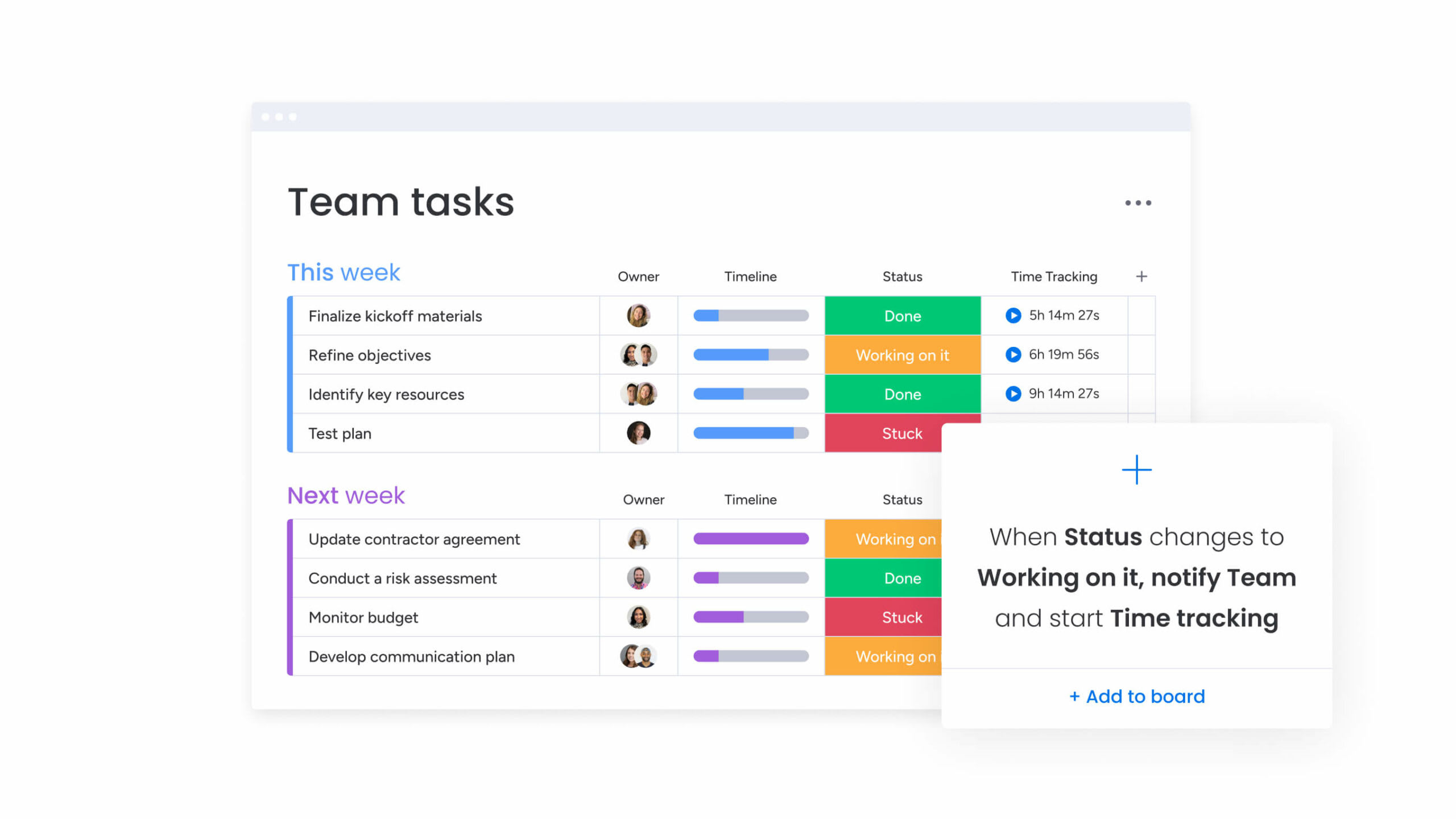
Why use monday.com for project management?
Built on the robust monday.com Work OS, monday work management goes beyond project management software because it allows teams to manage all projects and tasks from a single, centralized location.
Our solution means teams can:
- See project progress at a glance
- Stay on top of schedules and deadlines
- Collaborate more efficiently and effectively
- Build their dream workflows
Try our platform now by signing up for a free trial to organize your next projects. Or keep reading to learn more about project management trends and how to build a productive project management team.
Get startedThe future of project management: key trends to watch
Many project management trends shape how we work. There’s a lot of buzz around artificial intelligence (AI) and its implications in the project management sector by automating repetitive tasks and uncovering key insights. In response to this trend, monday work management now offers a built-in AI Assistant, offering a range of generative AI capabilities to automate task creations, email compositions, formula-building, and summarizations.
Industry professionals like world-renowned technology writer Peter Giffen have documented the power of innovations like AI:
AI could incorporate data analytics and automatically analyze project team data, providing clear indications about how to improve performance.
In addition to AI, there are three other project management trends we can expect in the near future:
- Project managers will need both AI and EI skills: EI — emotional intelligence — is becoming a required skill in the PM space. The ability to understand other humans is critical. Read this article for other essential project management skills.
- Adoption of customized or hybrid PM approaches: Gone are the days when a single PM methodology will suffice. Models will likely need to be flexible to accommodate different teams and various projects.
- A more diverse team structure: Increasingly diverse teams will bring a wider range of skills, experience, and technology to the table. Teams must learn how to embrace these diversities, to collaborate effectively and efficiently.
We’ve covered the project management phases, its frameworks, tips for success, and future trends, but what about the key players who will take the project from A-Z? We’re talking, of course, about your team.
With all this in mind, let’s now look at how to ensure you choose the right people for the project.
How can you build a productive project management team?
People are a core part of effective project management, but how you structure your project team largely depends on your framework and project scope. The good news is there are a few proven strategies for building a successful and productive team.
1. Recruit talent across departments
Your project team will likely come from different departments because projects benefit from and require varied expertise and input. Instead of hiring external talent, you can utilize existing resources and sync multiple departments on a larger organizational goal. For example, a new marketing campaign could require website designers, copywriters, and product managers who are already working for your internal teams. Use a Work OS to audit and display internal skills to build stronger teams for your next project.
2. Choose a project manager wisely and define responsibilities accurately
A project manager could be a professional PM or a subject matter expert (SME) — someone highly knowledgeable in the project area. A professional PM might play more of a facilitating role during initial planning. They allow stakeholders and SMEs to shape the project plan with hands-on experience. Smaller companies may be unable to afford a dedicated project manager role, in which case, an SME or executive is the logical choice.
3. Set an “all hands on deck” expectation
Empower your team members to exercise their own judgment, push forward by encouraging task ownership, and provide complete transparency of what’s expected in the project’s early stages. With remote working on the rise, you’ll also need flexible tools to accommodate different teams and various projects.
This is where the right project management software comes in. A tool like monday work management makes it easy to collaborate with team members, break down silos, and achieve more.
Create workflows your way with monday.com
Successful project management requires understanding the right approach to meet your needs. With monday work management, you get a comprehensive set of features to help you easily manage any project management methodology.
Why not sign up today for a free trial and see for yourself?
Curious as to what customers are saying about us? See reviews.
FAQs
What are the basics of project management?
The key components of project management are planning, organizing, communicating, monitoring and controlling numerous activities that must happen within the scope of a project. Using a platform like monday work management, you can stay on top of every element of your project, remain focused on specific goals, and objectives, and easily reach completion deadlines.
How do you learn project management?
Project management is a skill best acquired through practice. It involves understanding the different tools and techniques used, developing a plan for managing tasks, resources, and timelines, and applying project management principles to ensure the successful completion of projects. Various globally recognized professional accreditations, such as the Project Management Professional (PMP) certification, can further help you develop the necessary skills. Finally, networking with other project managers will ensure you stay on top of industry trends.
What is the difference between project management and program management?
The key difference between project management and program management lies in scope, complexity, and strategic impact. Project management focuses on delivering specific outcomes within defined constraints, while program management oversees multiple related projects to achieve broader organizational goals.
As a result, project managers concentrate on tactical execution and day-to-day operations with defined timelines, whereas program managers take a more strategic view, aligning projects with business objectives over a longer, often open-ended timeframe.
What is the difference between project management and project portfolio management?
Project management focuses on achieving a company's unique, short-term goal, while portfolio management focuses on balancing multiple projects that assist with achieving the company's long-term goals.
Project managers concentrate on tactical execution and day-to-day operations of single projects, whereas portfolio managers take a strategic view. They align and prioritize projects with business goals, optimize resource allocation across projects, and ensure the overall portfolio delivers maximum value to the organization.


